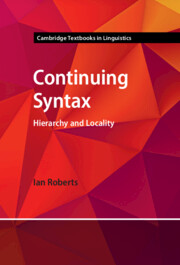Book contents
- Continuing Syntax
- Cambridge Textbooks in Linguistics
- Continuing Syntax
- Copyright page
- Contents
- Preface
- Abbreviations
- Part I Configuration and Hierarchy
- 1 Goals and Basic Assumptions
- 2 Hierarchy I: Phrase Structure and Grammatical Functions
- 3 Hierarchy II: C-Command, Head-Movement and Locality
- 4 Hierarchy and Categories I: Refining the Structure of the Clause and the VP
- 5 Hierarchy and Categories II: The Structure of Nominals
- 6 Case and the Nature of Infinitives
- 7 Features, Case and Agreement
- 8 Hierarchy and Linear Order
- 9 The Origins of Hierarchy: Bare Phrase Structure
- Part II Locality
- Glossary
- Book part
- Index
- References
9 - The Origins of Hierarchy: Bare Phrase Structure
from Part I - Configuration and Hierarchy
Published online by Cambridge University Press: aN Invalid Date NaN
- Continuing Syntax
- Cambridge Textbooks in Linguistics
- Continuing Syntax
- Copyright page
- Contents
- Preface
- Abbreviations
- Part I Configuration and Hierarchy
- 1 Goals and Basic Assumptions
- 2 Hierarchy I: Phrase Structure and Grammatical Functions
- 3 Hierarchy II: C-Command, Head-Movement and Locality
- 4 Hierarchy and Categories I: Refining the Structure of the Clause and the VP
- 5 Hierarchy and Categories II: The Structure of Nominals
- 6 Case and the Nature of Infinitives
- 7 Features, Case and Agreement
- 8 Hierarchy and Linear Order
- 9 The Origins of Hierarchy: Bare Phrase Structure
- Part II Locality
- Glossary
- Book part
- Index
- References
Summary
In this chapter I present the main elements of the theory of bare phrase structure: principally the basic operation Merge. This operation replaces phrase-structure rules of all kinds, including the X′-theoretic ones, as the generative component of the theory. We will see that c-command can be directly derived from the effects of Merge. We will also see that Merge can give us a notion of projection. We look at the relation between Merge and LCA, and also introduce the Labelling Algorithm.
Information
- Type
- Chapter
- Information
- Continuing SyntaxHierarchy and Locality, pp. 176 - 194Publisher: Cambridge University PressPrint publication year: 2025
